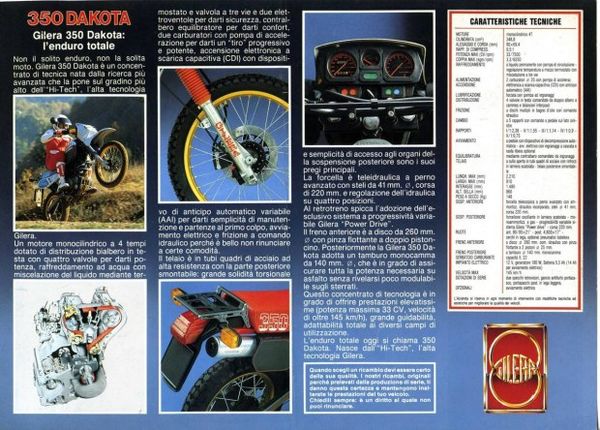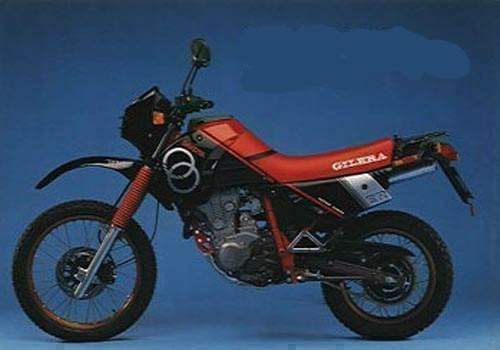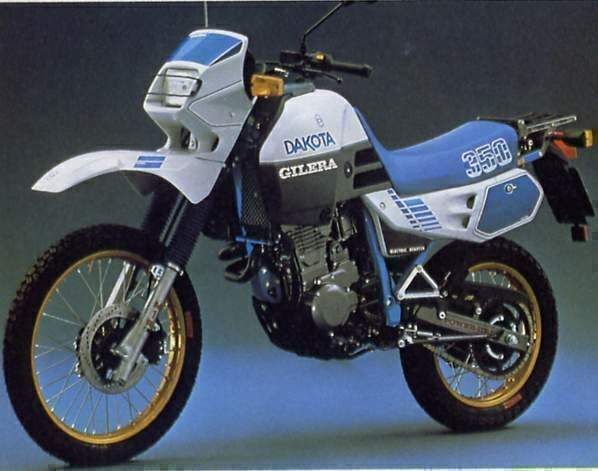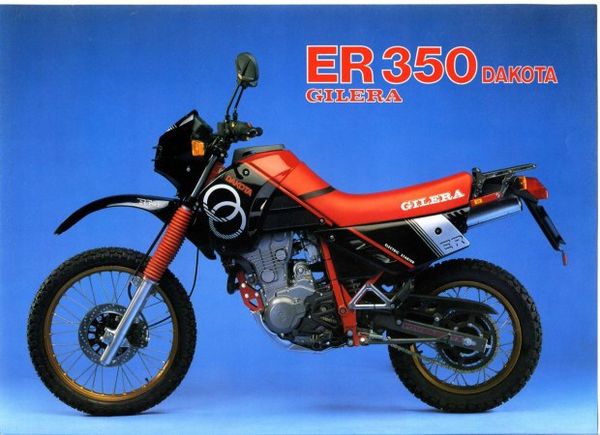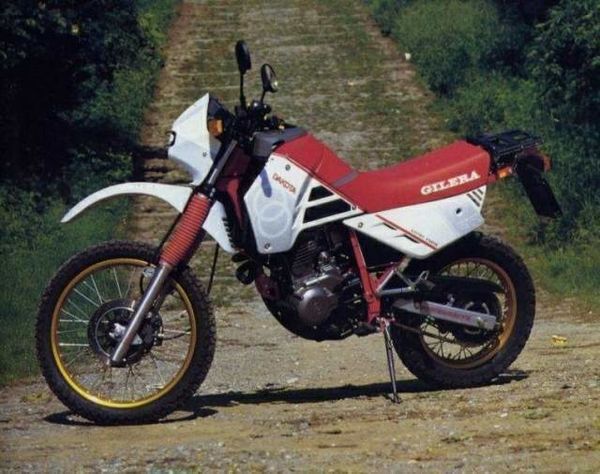Gilera ER350 Dakota
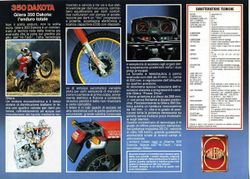 |
|
| Gilera ER350 Dakota | |
| Manufacturer | |
|---|---|
| Production | 1987 - |
| Engine | Four stroke, single cylinder, DOHC, 4 valves |
| Compression ratio | 9.5:1 |
| Ignition | CDI |
| Transmission | 5 Speed |
| Frame | Tubular steal, engine as stressed member. |
| Suspension | Front: 38mm Marzocchi telescopic forks, 220mm wheel travel. Rear: Single shock, 220mm wheel travel |
| Brakes | Front: Single 260mm disc 2 piston caliper Rear: 160mm Drum |
| Front Tire | 90/90 -21 |
| Rear Tire | 120/80 -17 |
| Weight | 148 kg / 326 lbs (dry), |
| Fuel Capacity | 22 Liters / 5.8 US gal |
| Manuals | Service Manual |
Engine[edit | edit source]
The engine was a Liquid cooled cooled Four stroke, single cylinder, DOHC, 4 valves. The engine featured a 9.5:1 compression ratio.
Chassis[edit | edit source]
It came with a 90/90 -21 front tire and a 120/80 -17 rear tire. Stopping was achieved via Single 260mm disc 2 piston caliper in the front and a 160mm Drum in the rear. The front suspension was a 38mm Marzocchi telescopic forks, 220mm wheel travel. while the rear was equipped with a Single shock, 220mm wheel travel. The ER350 Dakota was fitted with a 22 Liters / 5.8 US gal fuel tank. The bike weighed just 148 kg / 326 lbs.
Photos[edit | edit source]
Overview[edit | edit source]
Gilera ER Dakota 350
The first the world saw of the new Gilera four-stroke during the 1980s was at
the biennial Milan Show in November 1985. Not only did the famous old Arcore
factory have one of the biggest and most impressive stands at the exhibition,
but also an exciting new thumper in the shape of the 350 Dakota trailster, with
the added promise of a larger version in the pipeline.
And Gilera's first new four-stroke in over a decade showed that it wasn't
just two-stroke models which were receiving the
modern treatment in the Arcore R&D shop.
FOUR-VALVES
Designed by Ing. Lucio Masut, the newcomer employed every trick in the book - including liquid cooling, four-valve cylinder head, twin exhaust ports, twin 25 Dell'Orto carbs, double overhead camshafts driven by toothed belt, a balancer shaft (gear driven directly off the crankshaft) multi-plate hydraulically operated wet clutch, five-speed gearbox and Japanese electronic ignition and electric starter. There was also a forged piston and a one-piece crankshaft which ran on anti-vibration ring bearings. The pity was that all this hi-tech only produced 33bhp at 7,500rpm from the 348.8cc (80 x 69mm) mill. But at least the 500 (which took another eighteen months) promised a 25 per cent power increase with no additional weight to speak of.
DUAL-PURPOSE
Gilera had opted to build a dual-purpose, on-off-roader rather than a pure street bike because, at the time, sales of machines like Yamaha's Tenere were riding high. The Paris-Dakar style was all the rage both in Italy and around Europe; in fact everywhere except Great Britain! Even though the Dakota's power output was disappointing in view of its technical gizmos, the in-house Gilera styling job was generally accepted as being superb. As proof of this, author Alan Cathcart picked the Dakota to feature as only one of two machines with engines of less than 750-class in his 1988 book, Dream Bikes.
But besides the lack of power, the wide 5imp. gal (231tr) fuel tank and sculpted bodywork was slammed by serious off-road riders for its enforced 'knees-out' riding stance which, unless the rider adopted a more rearward seating position, (which then altered the weight distribution) was extremely uncomfortable.
THE ER VARIANT
Gilera responded in a positive fashion by introducing the ER variant in 1987, just as the 500 model 492cc (92 x 74mm) came into production. The ER was targeted firmly at the committed green lane rider, with its smaller 3.3imp. gal (151tr) tank and the twin coolant radiators now shrouded by abbreviated plastic panels. These two changes enabled the driver to sit further forward in a more comfortable position. The original model was also retained and, with both versions available in 350 and 500 form, this meant that there were actually four different Dakota models to choose from. With a dry weight of no less than 3241b (147kg) in both engine capacities, the Dakota was one of the heaviest machines in its class. This showed up most under heavy braking when the single 260mm disc and its Grimeca four-piston caliper was stretched to its limit to cope. The Gilera engine was the most sophisticated in the on-off-road sector of the market, but with its great weight and power-sapping ultra efficient (quiet!) exhaust system it was not really suitable for pure competition, even in its 500 form. However, the engine was very strong and the square-tube enduro-type chassis was fully capable of taking more power. The result was that at the Milan Show in 1987 Gilera launched the XRT.
Source Gilera The complete story Mick Walker
| Make Model | Gilera ER Dakota 350 |
|---|---|
| Year | 1987 - |
| Engine Type | Four stroke, single cylinder, DOHC, 4 valves |
| Displacement | 348.8 cc / 21.2 cu-in |
| Bore X Stroke | 80 x 69.4 mm |
| Cooling System | Liquid cooled |
| Compression | 9.5:1 |
| Induction | 2x 25mm Dell'Orto carburetor |
| Ignition | CDI |
| Starting | |
| Max Power | 39 hp / 29 kW @ 7750 rpm |
| Transmission | 5 Speed |
| Final Drive | Chain |
| Frame | Tubular steal, engine as stressed member. |
| Front Suspension | 38mm Marzocchi telescopic forks, 220mm wheel travel. |
| Rear Suspension | Single shock, 220mm wheel travel |
| Front Brakes | Single 260mm disc 2 piston caliper |
| Rear Brakes | 160mm Drum |
| Front Tire | 90/90 -21 |
| Rear Tire | 120/80 -17 |
| Dry Weight | 148 kg / 326 lbs |
| Fuel Capacity | 22 Liters / 5.8 US gal |
